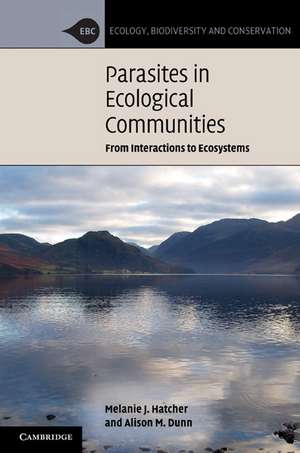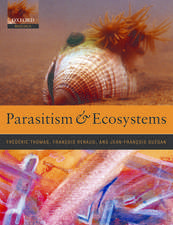Parasites in Ecological Communities: From Interactions to Ecosystems: Ecology, Biodiversity and Conservation
Autor Melanie J. Hatcher, Alison M. Dunnen Limba Engleză Hardback – 15 iun 2011
| Toate formatele și edițiile | Preț | Express |
|---|---|---|
| Paperback (1) | 451.52 lei 3-5 săpt. | |
| Cambridge University Press – 15 iun 2011 | 451.52 lei 3-5 săpt. | |
| Hardback (1) | 707.07 lei 6-8 săpt. | |
| Cambridge University Press – 15 iun 2011 | 707.07 lei 6-8 săpt. |
Din seria Ecology, Biodiversity and Conservation
-
 Preț: 349.59 lei
Preț: 349.59 lei -
 Preț: 276.13 lei
Preț: 276.13 lei -
 Preț: 230.82 lei
Preț: 230.82 lei -
 Preț: 307.24 lei
Preț: 307.24 lei -
 Preț: 356.75 lei
Preț: 356.75 lei -
 Preț: 274.22 lei
Preț: 274.22 lei -
 Preț: 303.90 lei
Preț: 303.90 lei -
 Preț: 351.53 lei
Preț: 351.53 lei -
 Preț: 305.81 lei
Preț: 305.81 lei -
 Preț: 320.13 lei
Preț: 320.13 lei -
 Preț: 355.36 lei
Preț: 355.36 lei -
 Preț: 278.29 lei
Preț: 278.29 lei -
 Preț: 353.48 lei
Preț: 353.48 lei -
 Preț: 328.88 lei
Preț: 328.88 lei -
 Preț: 311.14 lei
Preț: 311.14 lei -
 Preț: 387.22 lei
Preț: 387.22 lei - 11%
 Preț: 451.52 lei
Preț: 451.52 lei - 8%
 Preț: 530.72 lei
Preț: 530.72 lei -
 Preț: 314.82 lei
Preț: 314.82 lei -
 Preț: 306.10 lei
Preț: 306.10 lei -
 Preț: 471.17 lei
Preț: 471.17 lei -
 Preț: 466.38 lei
Preț: 466.38 lei -
 Preț: 402.68 lei
Preț: 402.68 lei - 14%
 Preț: 981.14 lei
Preț: 981.14 lei -
 Preț: 454.76 lei
Preț: 454.76 lei - 11%
 Preț: 565.77 lei
Preț: 565.77 lei - 14%
 Preț: 709.39 lei
Preț: 709.39 lei -
 Preț: 441.83 lei
Preț: 441.83 lei - 14%
 Preț: 929.04 lei
Preț: 929.04 lei - 11%
 Preț: 477.70 lei
Preț: 477.70 lei - 14%
 Preț: 701.48 lei
Preț: 701.48 lei - 14%
 Preț: 1013.18 lei
Preț: 1013.18 lei
Preț: 707.07 lei
Preț vechi: 794.46 lei
-11% Nou
Puncte Express: 1061
Preț estimativ în valută:
135.30€ • 147.43$ • 114.01£
135.30€ • 147.43$ • 114.01£
Carte tipărită la comandă
Livrare economică 23 aprilie-07 mai
Preluare comenzi: 021 569.72.76
Specificații
ISBN-13: 9780521889704
ISBN-10: 0521889707
Pagini: 464
Ilustrații: 113 b/w illus. 7 tables
Dimensiuni: 158 x 235 x 26 mm
Greutate: 0.86 kg
Editura: Cambridge University Press
Colecția Cambridge University Press
Seria Ecology, Biodiversity and Conservation
Locul publicării:Cambridge, United Kingdom
ISBN-10: 0521889707
Pagini: 464
Ilustrații: 113 b/w illus. 7 tables
Dimensiuni: 158 x 235 x 26 mm
Greutate: 0.86 kg
Editura: Cambridge University Press
Colecția Cambridge University Press
Seria Ecology, Biodiversity and Conservation
Locul publicării:Cambridge, United Kingdom
Cuprins
Part I. Introduction; Part II. Parasites and Competitors: 1. Introduction; 2. One host-one parasite systems; 3. Apparent competition; 4. Parasite-mediated competition; 5. Parasite-modified competition; 6. Examples from conservation and management; 7. Competition between parasites; 8. Conclusions; Part III. Parasites and Predators: 9. Introduction; 10. Parasites of prey with specialist predators; 11. Parasites of prey with generalist predators; 12. Parasites of predator; 13. Parasites of predator and prey; 14. Applications: predator control and harvesting; 15. Conclusions; Part IV. Parasites and Intraguild Predation: 16. Introduction; 17. Ecological significance of IGP; 18. IGP as a unifying framework for competition and predation; 19. Parasites intrinsic to IGP; 20. Parasites extrinsic to IGP; 21. Models of parasitism extrinsic to IGP; 22. IGP and the evolution of host-parasite relationships; 23. Conclusions; Part V. Plant Pathogens and Parasitic Plants: 24. Introduction: parasitism of plants; 25. Soil borne pathogens; 26. Plant defence strategies; 27. Parasitic plants; 28. Endophytes; 29. Conclusions; Part VI. Parasites and Invasions: 30. Introduction; 31. Parasite introduction and acquisition; 32. Loss of parasites by invaders: enemy release; 33. Invasions and host-parasite co-evolution; 34. The impact of parasitism on biological invasion; 35. Conclusions; Part VII. Ecosystem Parasitology: 36. Introduction; 37. Trophic cascades; 38. Parasite dynamics in multihost communities; 39. Biodiversity and disease; 40. Parasites in the food web; 41. Bioenergetic implications of parasitism; 42. Ecosystem engineering; 43. Ecosystem health; 44. Evolutionary considerations; 45. Conclusions; Part VIII. Emerging Diseases in Humans and Wildlife: 46. Introduction; 47. The process of disease emergence; 48. The evolution of emergence; 49. Phylogenetic and temporal patterns of emergence; 50. Environmental change and emergence; 51. Conservation and control; 52. Conclusions; Part IX. Where Do We Go From Here?; References; Index.
Recenzii
'Hatcher and Dunn have done us a great service. Theirs is an important and timely book that should catalyse research at the interface of epidemiology and community ecology. It reads well … is also well referenced … With its nice combination of models and empirical examples, [this book] seems tailor-made for a graduate course in community ecology or ecological parasitology.' Robert Poulin, Ecology
'The ecology of infectious disease is a fast growing topic … To date, there has not been an adequate text to teach from. [This book] … fills this niche well. In contrast to contributed volumes, [it] speaks with a single voice. The authors use themes centered around mathematical epidemiology and community ecology, but they do so in such a way that is accessible to non-math savvy students … does a very good job summarizing the relevant literature in tables that efficiently indicate who has done what on a particular question. The text covers many systems … We just finished using it in our graduate seminar and found it to be up to date and comprehensive. Since then, I have referred to it regularly … will be required reading for our future graduate students … should be required reading for any ecologist.' Kevin Lafferty, US Geological Survey
'This is a very useful book which is likely to have considerable impact in stimulating both theoretical as well as empirical studies on the way in which parasites manipulate and modify the world in which we live. It is particularly recommended to graduate and postgraduate students for its logical, comprehensive layout and the wealth of literature, mostly recent, which is discussed.' Trevor Petney, Singapore Journal of Tropical Geography
'The ecology of infectious disease is a fast growing topic … To date, there has not been an adequate text to teach from. [This book] … fills this niche well. In contrast to contributed volumes, [it] speaks with a single voice. The authors use themes centered around mathematical epidemiology and community ecology, but they do so in such a way that is accessible to non-math savvy students … does a very good job summarizing the relevant literature in tables that efficiently indicate who has done what on a particular question. The text covers many systems … We just finished using it in our graduate seminar and found it to be up to date and comprehensive. Since then, I have referred to it regularly … will be required reading for our future graduate students … should be required reading for any ecologist.' Kevin Lafferty, US Geological Survey
'This is a very useful book which is likely to have considerable impact in stimulating both theoretical as well as empirical studies on the way in which parasites manipulate and modify the world in which we live. It is particularly recommended to graduate and postgraduate students for its logical, comprehensive layout and the wealth of literature, mostly recent, which is discussed.' Trevor Petney, Singapore Journal of Tropical Geography
Notă biografică
Descriere
Links community ecology and epidemiology to demonstrate how parasites affect species interactions and consequently ecosystem function, invasions and emerging diseases.










